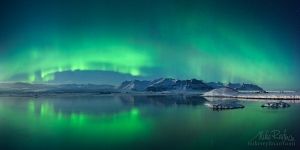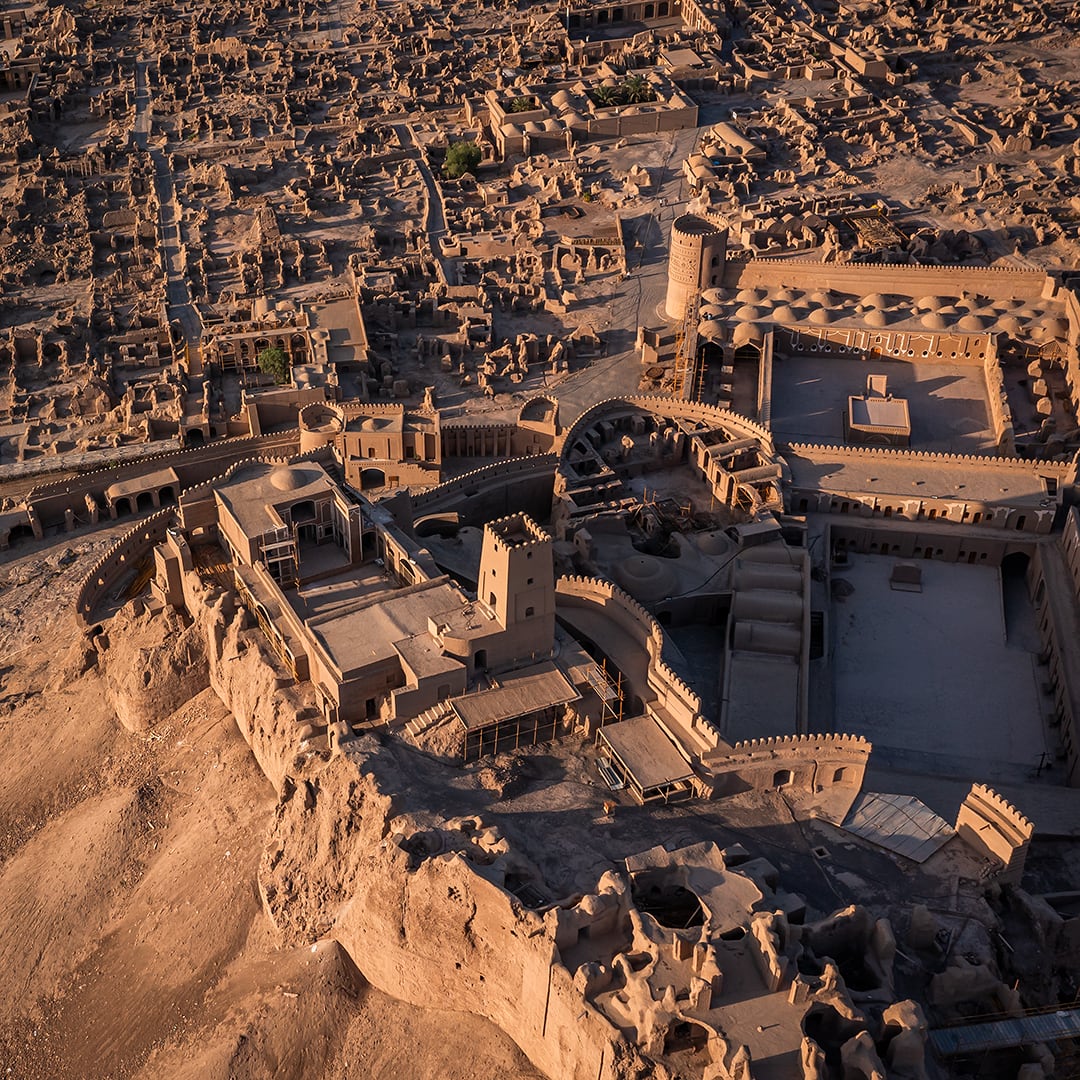Polar lights in Iceland
It is not an easy thing to capture the northern lights. It's not enough just to come to the polar circle; three important factors should coincide:
— Solar activity,
— Clear sky,
— Impressing foreground.
These panoramas were photographed in Iceland and due to the known charm of its nature, this country has no problems when it comes to the beautiful foreground. We were monitoring the aurora forecast on a special web-site, which could give more or less correct prediction of the solar activity. As for the weather forecast, we were checking it on the Internet, too. Especially the cloudiness map. Both forecasts were 70% reliable; but still, the possibility to witness colourful skies, in case all the conditions coincide, is very high.

Our expedition lasted two weeks and the solar activity was predicted to occur only a couple of times during our stay. In the northern part of the country, near the Mývatn lake, the spectacular Godafoss waterfall is situated. Upon our arrival we decided to spend a couple of days (or rather nights) here to chase the lights. The forecast predicted solar activity — not a strong one, but the sky promised to be clear. Ten kilometres away from the waterfall we managed to find a good hotel with its own warm outdoor swimming pool. Having finished our work that was planned for the day we had a supper and went bathing in the warm water, which was coming into the pool straight from the thermal springs. But as soon as we sank into the pool and started enjoying the warmth (it was 17C° below zero outside), someone noticed a strange stripe in the sky that was not actually a cloud. Here we should note that a weaker northern light falls below the visual range of a human eye, and is perceived as a greyish mist, though the digital sensor of the camera reveals its green colour. So we rushed out of the pool and in ten minutes were on our way to the waterfall.
That night we managed to catch some pretty flashes, but in general, the aurora was not intense. The following night almost the same thing happened, and on the third night we decided to stay in the pool a little bit longer — we were not interested in weak lights anymore. But when the colour of lights began to change from greyish to green, we realised that we had to change the comfort and bliss of the warm swimming pool to the shiver against a chilling wind.

Several photographers had already come to the waterfall. The light grew brighter right in front of our eyes. First it appeared as thin stripes above the horizon, then it flashed right above our heads. Shades of purple and yellow appeared. And suddenly a truly magical show began. Fantastic bright images appeared one by one in the sky: first the glow looked like a dragon with spread wings, then it turned into an Indian wearing a war-bonnet with colourful feathers. Sometimes it resembled dazzling fireworks in the sky. I stood absolutely spellbound, cried something with delight and pushed the shutter-button at times not caring about the foreground. The show lasted for around three minutes, then it ceased just as abruptly as it had begun. Those few stripes that remained in the sky could not compare to what had happened just before!

Since then the sky and the forecasts were not promising at all, throughout the whole week. Probably, something could have been happening in the sky, but the clouds did not give us another chance. And still, the day before our departure the forecast changed.
The strongest disturbance of the solar atmosphere promised to occur right on the night before our flight to Moscow. Luckily for us, the peninsula where Keflavik airport was situated, was the only place not covered by clouds. Having arrived a couple of hours before the intended time of shooting, we examined several potential locations: a small church (appeared too brightly lit), a small port (too bright, as well), a frozen lake (there could be some nice reflections, but the total absence of stones or any other details could not make an interesting foreground). On the remote corner of the peninsula we found an old lighthouse. It was not functioning and most probably served as a museum. A new lighthouse stood close to it and illuminated the building in a proper way.
As soon as we finished examining the area, the first glows of the northern light appeared: an hour earlier than the forecast predicted. It was time to take out our cameras and use them.

The northern lights are rather unpredictable: it can appear as a thin stripe over the horizon, or it can spread over the whole dome of the sky. Not willing to miss even the smallest detail, I chose the lens Nikkor 14mm 2,8. But even having this kind of ultra-wide lens I had to take several shots in order to merge them into a panorama.
Using Liveview mode I manually set the focus on the lighthouse and fixed the ring with a sticky tape, in case I accidentally touch it in the darkness.
I chose ISO 2500, as a compromise between high ISO speed and a relatively low level of noise. I also stopped down the aperture to f3,5. As for the shutter speed, I wanted to experiment on it. The point is that the northern light is a rather dynamic phenomenon. The parts of the sky are constantly shimmering, so in a couple of minutes the picture can change dramatically. To have enough light for the picture and not to blur the glow at the same time, I used the shutter speed at 1/10 sec (note that I had to merge a panorama, consisting of several pictures).
In half an hour we managed to create a dozen of panoramas. The sky was constantly changing: first the light looked like thin stripes across the sky, then it changed to a wide twisting "blanket", or sometimes the whole sky was covered with greenish mist.

But the main mission of this evening was the creation of a high-quality 360° time-lapse video of the northern light. For this purpose, the members of the AirPano team had designed a special device, affectionately named "Gorynych" (Russian name for a Fairy Dragon). The installation and setup of this device is a rather difficult thing, but the task was too important. And simply, we are not used to giving up. Having spent 15 minutes on the equipment I managed to install it, deal with the settings and place it in a picturesque place. I was worrying about strong gusts of wind, which were not only shaking the tripod, but could totally blow off the whole construction as well. So, after the installing and launching I had to check the rig every couple of minutes. When it had finished its "job", I couldn't believe that everything went ok — the conditions were too extreme.
Batteries in the "Gorynych" died just at the moment when the glow began ceasing and the light grew weaker. We packed the equipment and just sat watching the end of the "show". We were lucky for the second time, but still — this light was not as intense as the one we saw near the Godafoss waterfall.
Early in the morning we boarded the plane back home. The forecast promised an intense lasting solar activity just after our departure. But we decided not to change our tickets: there would be one more reason to come back here again.

Earlier we have published photo panoramas of polar lights. Now we present 360° time-lapse video of it.
Authors of the video: Dmitry Moiseenko and Ivan Roslyakov
29 March 2016
Read more
 Aurora in the Jökulsárlón lagoon
Aurora in the Jökulsárlón lagoon
 Northern Lights over Iceland snow
Northern Lights over Iceland snow
 Dragon
Dragon
 Polar lights in Iceland
Polar lights in Iceland
 Aurora above the Jökulsárlón lagoon
Aurora above the Jökulsárlón lagoon
 Aurora above the Jökulsárlón lagoon
Aurora above the Jökulsárlón lagoon
 Keflavik
Keflavik
 Aurora above the Jökulsárlón lagoon
Aurora above the Jökulsárlón lagoon
 Aurora in the Jökulsárlón lagoon
Aurora in the Jökulsárlón lagoon
 Northern lights over the Godafoss waterfall. Planeta
Northern lights over the Godafoss waterfall. Planeta
 Aurora above the Jökulsárlón lagoon
Aurora above the Jökulsárlón lagoon
 Northern lights over the Godafoss waterfall
Northern lights over the Godafoss waterfall
Virtual Travels in 360°
 Sahara Desert, Algeria. Part II
Sahara Desert, Algeria. Part II
 Vernazza, Cinque Terre, Italy
Vernazza, Cinque Terre, Italy
 Agra Fort, India
Agra Fort, India
 Seville, Spain
Seville, Spain
 The best panoramas made by AirPano in 2016
The best panoramas made by AirPano in 2016
 Trip to Tokyo, Japan
Trip to Tokyo, Japan
 Dunhuang Yardang National Geopark, China
Dunhuang Yardang National Geopark, China
 Spring in Moscow
Spring in Moscow
 Huangshan mountains, China
Huangshan mountains, China
 Four Seasons. Autumn Forest. Relax Flight
Four Seasons. Autumn Forest. Relax Flight
 Natural Wonders in Bali. Relaxation VR video in 16K
Natural Wonders in Bali. Relaxation VR video in 16K
Show more










